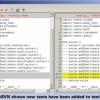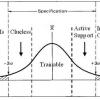|
|
The Next Stop in Test Automation: Test Environment Setup To achieve the most effective test automation, you need to go beyond automated test case creation and implement automated environment setup. In tracking the testing time spent over several projects, the Clustering group Amit Mathur worked with found that more staff time was being spent on setup than on actual testing. He discusses and demonstrates the Environment Configuration System (ECS) his group developed to automatically set up test environments and trigger automated test execution. Find out how ECS has dramatically improved the ability to automate many more manual tests. ECS employs a scripting language (Perl) and libraries for environment setup and test cases. Based on interface specifications and dependency rules, ECS bundles environment setups and test cases for complex test scenarios. Learn how you can adapt the ECS approach for your applications and environment.
|
Amit Mathur, VERITAS Software Corporation
|
 |
A Look at Canoo WebTest Need to get the scoop on the latest software tests and trends? You've come to the right place. Get one reviewer's opinion of Canoo WebTest, an open source tool that supports Web application development through test automation.
|
|
|
|
Journey to Test Automation Maturity Organizations that want to automate their testing generally go through a number of stages before they reach maturity. Whether you are about to begin your journey or are well under way, it is important to know where you are going and where you could go. In automating test execution, many organizations stop short of achieving their maximum benefits. This presentation looks at six levels of maturity in test automation and includes a self-assessment test to see where you are. It is important to have good objectives and realistic plans to achieve them. But in automating testing, these often seem very plausible at first but are not well expressed or are unrealistic. This presentation covers typical problems and examples of unrealistic automation plans and objectives. Leave with advice to help you have a successful journey to test automation.
|
Dorothy Graham, Grove Consultants
|
|
|
The Venerable Triangle Redux Jerry Weinberg's venerable triangle problem has been around since 1966 and was popularized in Glenford Myers' book The Art of Software Testing. To assess a tester's effectiveness, many software companies have used the triangle problem as an interview question. But, past studies indicate testers' effectiveness at solving the problem is relatively low. Recent studies by noted experts indicate that a significant number of testers in the industry lack formal training in software testing techniques. Over a three-year period Microsoft conducted several experiments to accurately quantify the effectiveness of testers with different years of experience and skill.
|
William Rollison, Microsoft Corporation
|
|
|
Risk: The Testers Favorite Four Letter Word Identifying risk is important-but managing risk is vital. Good project managers speak the language of risk, and their understanding of risk guides important decisions. Testers can contribute to an organization's decision making ability by speaking that same language. Learn from Julie Gardiner how to evaluate risk in both quantitative and qualitative ways. Julie will discuss how to deal with some of the misconceptions managers have about risk-based testing including: Testing is always risk-based. Risk-based testing is nothing more than prioritizing tests. Risk-based testing is a one-time-only activity. Risk-based testing is a waste of time. And risk-based testing will delay the project.
|
Julie Gardiner, QST Consultants Ltd.
|
|
|
It's 2005, Why Does Software Still Stink We've now been writing software for an entire human generation. Yet software is arguably the least reliable product ever produced. People expect software to fail, and our industry has developed a well-deserved and widely accepted reputation for its inability to deliver quality products. James Whittaker explores the history of software development over the last generation to find out why. He uncovers several attempts to solve the problem and exposes their fatal flaws. James then looks forward to a world without software bugs and offers a roadmap-practical techniques that can be implemented today-for how to get there from here. Join James on this journey through the past and into the future-and be sure to bring something to scrape the bugs off your windshield.
|
James Whittaker, Florida Institute of Technology
|
|
|
Six Impossible Truths about Developing Software - All Before Breakfast Alice laughed. "There’s no use trying," she said, "one can't believe impossible things."
"I daresay you haven't had much practice," said the Queen. "When I was younger, I always did it for half an hour a day. Why, sometimes I've believed as many as six impossible things before breakfast."
--Alice in Wonderland
|
Tim Lister, Atlantic Systems Guild, Inc
|
|
|
Multi-Attribute Software Analysis Although the methods for measuring individual quality characteristics of software (performance, functionality, etc.) are well known, few organizations have developed useful metrics to evaluate overall software quality. Recently, several large software organizations have found multi-attribute software analysis a valuable method to measure the progress of software development and to assess a product’s ship readiness. Learn how to use the analytic hierarchy technique and a simple multi-attribute rating system to quickly evaluate the overall quality of your software. Use the multi-attribute software analysis to compare the overall quality of your product to your competitors' product. Go beyond the muddle of multiple conflicting measures to a more crisp and useful quality metric.
|
James McCaffrey, Volt Information Sciences, Inc.
|
 |
A Look at Subversion 1.2 Need to get the scoop on the latest software tests and trends? You've come to the right place. Get one reviewer's opinion of Subversion 1.2.
|
|
 |
Is the Grass Greener on the Other Side of the Fence? We may be creatures of habit—adhering to and promoting processes we know well—but we also habitually look to other work environments that appear capable of nurturing our ideas once an old environment becomes depleted. Ed Weller believes that searching for greener pastures is unnecessary. You just need to learn how to cultivate your managers in order to create an environment that will harbor your ideas. Ed explains why you'll end up grazing fruitlessly if you can't plant your ideas with management.
|
|

